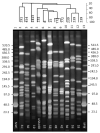Genotypic Characterization of Clinical Isolates of Staphylococcus aureus from Pakistan
- PMID: 34451382
- PMCID: PMC8400278
- DOI: 10.3390/pathogens10080918
Genotypic Characterization of Clinical Isolates of Staphylococcus aureus from Pakistan
Abstract
In this study, we compared pulsed-field gel electrophoretic (PFGE), multilocus sequence typing (MLST), Staphylococcal cassette chromosome mec (SCCmec), spa typing, and virulence gene profiles of 19 Panton-Valentine leucocidin (PVL)-positive, multidrug-, and methicillin-resistant clinical Staphylococcus aureus (MRSA) isolates obtained from a hospital intensive care unit in Pakistan. The isolates exhibited 10 pulsotypes, contained eight adhesin genes (bbp, clfA, clfB, cna, fnbA, fnbB, map-eap, and spa), 10 toxin genes (hla, hlb, hld, hlg, pvl, sed, see, seg, seh, and tst), and two other virulence genes (cfb, v8) that were commonly present in all isolates. The spa-typing indicated seven known spa types (t030, t064, t138, t314, t987, t1509, and t5414) and three novel spa types. MLST analysis indicated eight ST types (ST8, ST15, ST30, ST239, ST291, ST503, ST772, and ST1413). All isolates belonged to the agr group 1. Most of the isolates possessed SCCmec type III, but some isolates had it in combination with types SCCmec IV and V. The presence of multidrug-resistant MRSA isolates in Pakistan indicates poor hygienic conditions, overuse of antibiotics, and a lack of rational antibiotic therapy that have led to the evolution and development of hypervirulent MRSA clones. The study warrants development of a robust epidemiological screening program and adoption of effective measures to stop their spread in hospitals and the community.
Keywords: MLST; SCCmec; Staphylococcus aureus; evolution; genes; methicillin resistance; virulence.
Conflict of interest statement
The authors declare no conflict of interest.
Figures


Similar articles
-
Molecular characteristics of methicillin-resistant Staphylococcus aureus (MRSA) strains isolated from patients with bacteremia based on MLST, SCCmec, spa, and agr locus types analysis.Microb Pathog. 2017 Mar;104:328-335. doi: 10.1016/j.micpath.2017.01.055. Epub 2017 Feb 1. Microb Pathog. 2017. PMID: 28159661
-
Genotyping of community-associated methicillin resistant Staphylococcus aureus (CA-MRSA) in a tertiary care centre in Mysore, South India: ST2371-SCCmec IV emerges as the major clone.Infect Genet Evol. 2015 Aug;34:230-5. doi: 10.1016/j.meegid.2015.05.032. Epub 2015 Jun 1. Infect Genet Evol. 2015. PMID: 26044198
-
Prevalence, Genetic Diversity, and Temporary Shifts of Inducible Clindamycin Resistance Staphylococcus aureus Clones in Tehran, Iran: A Molecular-Epidemiological Analysis From 2013 to 2018.Front Microbiol. 2020 Apr 30;11:663. doi: 10.3389/fmicb.2020.00663. eCollection 2020. Front Microbiol. 2020. PMID: 32425898 Free PMC article.
-
[Infectivity-resistotype-genotype clustering of methicillin-resistant Staphylococcus aureus strains in the Central Blacksea Region of Turkey].Mikrobiyol Bul. 2014 Jan;48(1):14-27. Mikrobiyol Bul. 2014. PMID: 24506712 Turkish.
-
Genetic diversity of methicillin resistant Staphylococcus aureus strains isolated from burn patients in Iran: ST239-SCCmec III/t037 emerges as the major clone.Microb Pathog. 2017 Apr;105:1-7. doi: 10.1016/j.micpath.2017.02.004. Epub 2017 Feb 5. Microb Pathog. 2017. PMID: 28179118
Cited by
-
Characterization of virulence factors and antimicrobial resistance in Staphylococcus spp. isolated from clinical samples.Folia Microbiol (Praha). 2024 Oct;69(5):1043-1052. doi: 10.1007/s12223-024-01148-1. Epub 2024 Feb 17. Folia Microbiol (Praha). 2024. PMID: 38367164
-
Antimicrobial resistance and virulence profiles of staphylococci isolated from clinical bovine mastitis.Front Microbiol. 2023 Jun 29;14:1190790. doi: 10.3389/fmicb.2023.1190790. eCollection 2023. Front Microbiol. 2023. PMID: 37455736 Free PMC article.
-
Comparative Genomic Analysis of a Panton-Valentine Leukocidin-Positive ST22 Community-Acquired Methicillin-Resistant Staphylococcus aureus from Pakistan.Antibiotics (Basel). 2022 Apr 8;11(4):496. doi: 10.3390/antibiotics11040496. Antibiotics (Basel). 2022. PMID: 35453247 Free PMC article.
-
Genomic Investigation of Methicillin-Resistant Staphylococcus aureus ST113 Strains Isolated from Tertiary Care Hospitals in Pakistan.Antibiotics (Basel). 2021 Sep 17;10(9):1121. doi: 10.3390/antibiotics10091121. Antibiotics (Basel). 2021. PMID: 34572703 Free PMC article.
-
S. aureus drives itch and scratch-induced skin damage through a V8 protease-PAR1 axis.Cell. 2023 Nov 22;186(24):5375-5393.e25. doi: 10.1016/j.cell.2023.10.019. Cell. 2023. PMID: 37995657 Free PMC article.
References
-
- Fey P.D., Said-Salim B., Rupp M.E., Hinrichs S.H., Boxrud D.J., Davis C.C., Kreiswirth B.N., Schlieveret P.M. Comparative molecular analysis of community- or hospital-acquired methicillin-resistant Staphylococcus aureus. Antimicrob. Agents Chemother. 2003;47:196–203. doi: 10.1128/AAC.47.1.196-203.2003. - DOI - PMC - PubMed
-
- Fukuta Y., Cunningham C.A., Harris P.L., Wagener M.M., Muder R.R. Identifying the risk factors for hospital-acquired methicillin-resistant Staphylococcus aureus (MRSA) infection among patients colonized with MRSA on admission. Infect. Control Hosp. Epidemiol. 2012;33:1219–1225. doi: 10.1086/668420. - DOI - PubMed
-
- Eriksen K.R. “Celbenin”-resistant staphylococci. Ugeskr. Laeger. 1961;123:384–386. - PubMed
-
- Ahmad M.K., Asrar A. Prevalence of methicillin resistant Staphylococcus aureus in pyogenic community and hospital acquired skin and soft tissues infections. J. Pak. Med. Assoc. 2014;64:892–895. - PubMed
Grants and funding
LinkOut - more resources
Full Text Sources
Research Materials
Miscellaneous

